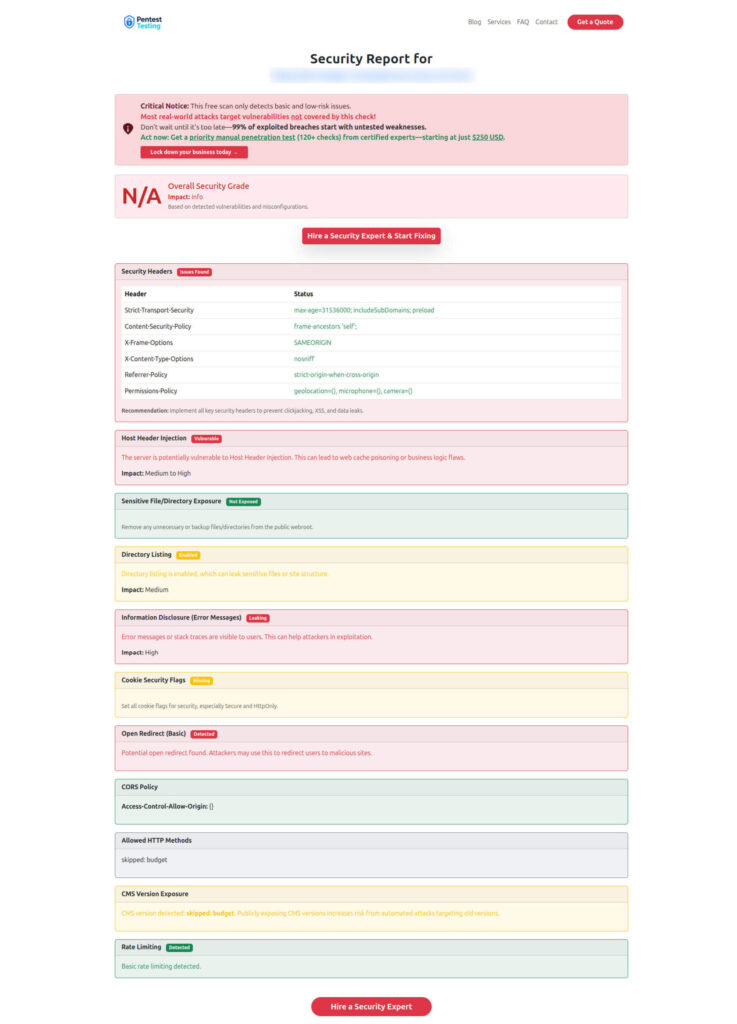10 Best Ways to Prevent Sensitive Data Exposure in Node.js
Sensitive Data Exposure in Node.js is one of those problems that sneaks in through small mistakes—an overly verbose error, a forgotten .env file pushed to Git, or a debug log that prints out access tokens. In this deep, hands-on guide you’ll learn practical steps (with copy-pasteable snippets) to prevent Sensitive Data Exposure in Node.js across config, code, logs, transport, and storage layers. We’ll also link resources and tools so you can audit your app quickly.

Quick resources:
- Related read on UI defense: Clickjacking Prevention in WordPress
- Previous posts on Cybersrely:
Why Sensitive Data Exposure in Node.js happens
- Secrets are hard-coded, checked into Git, or left in container images.
- Debug logs print request bodies, headers, or DB results with PII.
- Error handlers leak stack traces in production.
- Data is stored in plaintext in DBs or object storage.
- Weak TLS, misconfigured cookies, or missing security headers expose tokens.
Your goal: design and implement layers so that Sensitive Data Exposure in Node.js becomes unlikely, detectable, and limited in blast radius.
1) Keep secrets out of code and Git
Never hard-code credentials. Use environment variables, .env, or a secrets manager.
# .env (never commit this)
DATABASE_URL=postgres://user:pass@host:5432/app
JWT_SECRET=super-secret-key// config.js
import 'dotenv/config';
export const config = {
dbUrl: process.env.DATABASE_URL,
jwtSecret: process.env.JWT_SECRET,
};Pro tip: add a safe sample file.
# .env.example (safe to commit)
DATABASE_URL=
JWT_SECRET=This first step alone prevents a large class of Sensitive Data Exposure in Node.js incidents caused by accidental commits.
2) Use a secrets manager (rotation + auditing)
For production, prefer a managed secrets store (AWS Secrets Manager, GCP Secret Manager, Vault). Example with AWS Secrets Manager (SDK v3):
// secrets.js
import { SecretsManagerClient, GetSecretValueCommand } from "@aws-sdk/client-secrets-manager";
const client = new SecretsManagerClient({ region: "us-east-1" });
export async function getDbCredentials() {
const res = await client.send(new GetSecretValueCommand({ SecretId: "Prod/Database" }));
const secret = JSON.parse(res.SecretString);
return { user: secret.username, pass: secret.password, host: secret.host };
}Rotate secrets frequently and restrict IAM permissions using least privilege.
Screenshot of our free Website Vulnerability Scanner showing the homepage and scan button:

3) Encrypt sensitive fields at rest (AES-256-GCM)
If an attacker gets DB access, field-level encryption helps reduce Sensitive Data Exposure in Node.js.
// crypto.js
import crypto from 'node:crypto';
const ALGO = 'aes-256-gcm';
export function encrypt(plaintext, key) {
const iv = crypto.randomBytes(12);
const cipher = crypto.createCipheriv(ALGO, key, iv);
const enc = Buffer.concat([cipher.update(String(plaintext), 'utf8'), cipher.final()]);
const tag = cipher.getAuthTag();
return Buffer.concat([iv, tag, enc]).toString('base64');
}
export function decrypt(b64, key) {
const buf = Buffer.from(b64, 'base64');
const iv = buf.subarray(0, 12);
const tag = buf.subarray(12, 28);
const data = buf.subarray(28);
const decipher = crypto.createDecipheriv(ALGO, key, iv);
decipher.setAuthTag(tag);
const dec = Buffer.concat([decipher.update(data), decipher.final()]);
return dec.toString('utf8');
}Store key via a KMS (e.g., AWS KMS) so the app never sees raw master keys.
4) Minimize stored data + default to non-selectable fields
Only store what you absolutely need. With Mongoose:
// user.model.js
import mongoose from 'mongoose';
const userSchema = new mongoose.Schema({
email: { type: String, index: true },
// Never return these by default
passwordHash: { type: String, select: false },
ssnLast4: { type: String, select: false }, // consider avoiding storing at all
// PII flags
phone: { type: String },
}, { timestamps: true });
export default mongoose.model('User', userSchema);Now if a dev runs User.find(), the sensitive fields won’t be included unless explicitly requested.
5) Redact logs and headers (no PII in CloudWatch/ELK)
Debug logs are a major source of Sensitive Data Exposure in Node.js. Redact tokens, passwords, and PII.
// logger.js
import winston from 'winston';
const redactors = [/authorization/i, /password/i, /token/i, /secret/i, /ssn/i, /card/i];
function scrub(obj) {
if (!obj || typeof obj !== 'object') return obj;
const copy = Array.isArray(obj) ? [] : {};
for (const [k, v] of Object.entries(obj)) {
if (redactors.some(r => r.test(k))) {
copy[k] = '[REDACTED]';
} else if (typeof v === 'object') {
copy[k] = scrub(v);
} else {
copy[k] = v;
}
}
return copy;
}
const jsonFmt = winston.format.printf(({ level, message, ...meta }) => {
const m = typeof message === 'object' ? JSON.stringify(scrub(message)) : message;
return JSON.stringify({ level, message: m, ...scrub(meta) });
});
export const logger = winston.createLogger({
level: 'info',
transports: [new winston.transports.Console()],
format: winston.format.combine(winston.format.timestamp(), jsonFmt)
});Use it in routes without leaking request bodies:
app.use((req, _res, next) => {
const safeHeaders = { ...req.headers, authorization: '[REDACTED]' };
logger.info({ msg: 'request', method: req.method, path: req.path, headers: safeHeaders });
next();
});6) Fail safely: production error handler without stack traces
Stack traces, SQL, or file paths can leak secrets.
// errors.js
export function notFound(_req, res, _next) {
res.status(404).json({ error: 'Not Found' });
}
export function errorHandler(err, _req, res, _next) {
const isProd = process.env.NODE_ENV === 'production';
const safe = { error: 'Unexpected error. Please try again later.' };
if (!isProd) safe.details = err.message;
// Log full stack to secure sink (redacted logger)
// logger.error({ err });
res.status(500).json(safe);
}// app.js
app.use(notFound);
app.use(errorHandler);This approach reduces Sensitive Data Exposure in Node.js by design.
7) Use HTTPS, HSTS, and strong security headers
Install Helmet and set strict policies.
import helmet from 'helmet';
app.use(helmet({
hsts: { maxAge: 15552000, includeSubDomains: true, preload: true }, // 180 days
contentSecurityPolicy: {
useDefaults: true,
directives: {
"default-src": ["'self'"],
"script-src": ["'self'"],
"frame-ancestors": ["'none'"], // prevents clickjacking
}
}
}));Add Secure, HttpOnly, and SameSite flags to cookies:
import session from 'express-session';
app.use(session({
name: 'sid',
secret: process.env.SESSION_SECRET,
resave: false,
saveUninitialized: false,
cookie: { secure: true, httpOnly: true, sameSite: 'lax', maxAge: 1000 * 60 * 60 }
}));8) Properly handle file downloads and URLs
Avoid exposing internal paths; use pre-signed URLs or streaming. Example with AWS S3 pre-signed download (SDK v3):
import { S3Client, GetObjectCommand } from "@aws-sdk/client-s3";
import { getSignedUrl } from "@aws-sdk/s3-request-presigner";
const s3 = new S3Client({ region: 'us-east-1' });
app.get('/files/:id', async (req, res, next) => {
try {
// Check ACLs/ownership first
const key = `users/${req.user.id}/${req.params.id}`;
const url = await getSignedUrl(s3, new GetObjectCommand({ Bucket: 'my-bucket', Key: key }), { expiresIn: 60 });
res.json({ url }); // short TTL link; server never reveals raw storage creds
} catch (e) { next(e); }
});This drastically reduces Sensitive Data Exposure in Node.js through misconfigured static hosting.
9) Hash passwords correctly (never store plaintext)
Use argon2 or bcrypt.
import argon2 from 'argon2';
export async function hashPassword(pw) {
return argon2.hash(pw, { type: argon2.argon2id, memoryCost: 19456, timeCost: 2, parallelism: 1 });
}
export async function verifyPassword(pw, hash) {
return argon2.verify(hash, pw);
}10) Access control and least privilege everywhere
- Use DB users with limited permissions per service.
- For cloud storage, scope access to a single prefix per tenant.
- In APIs, check ownership and scopes before returning data:
// authz.js
export function requireScope(scope) {
return (req, res, next) => {
if (!req.user?.scopes?.includes(scope)) return res.status(403).json({ error: 'Forbidden' });
next();
};
}
// route
app.get('/me/profile', requireScope('read:profile'), async (req, res) => {
const profile = await getProfile(req.user.id);
res.json(profile);
});Sample assessment report by our free tool to check Website Vulnerability, highlighting findings and remediation steps:

Bonus safeguards to further cut Sensitive Data Exposure in Node.js
- Token hygiene: Prefer short-lived JWTs + refresh tokens stored in HttpOnly cookies.
- PII tagging: Add a
classificationmetadata field in schemas and enforce redaction on serialization. - Outbound webhooks: Sign payloads and avoid sending PII unless absolutely required.
- Monitoring: Alert on unusual log volume spikes or new error signatures (often signs of accidental exposure).
End-to-end example: a safe Express API
This tiny service demonstrates several controls together: redaction, safe errors, Helmet headers, and minimal responses.
import express from 'express';
import helmet from 'helmet';
import { errorHandler, notFound } from './errors.js';
import { logger } from './logger.js';
import { encrypt, decrypt } from './crypto.js';
const app = express();
app.use(helmet());
app.use(express.json());
app.post('/tokenize', (req, res) => {
const { cardLast4 } = req.body; // never accept full PAN
if (!/^\d{4}$/.test(cardLast4)) return res.status(400).json({ error: 'Invalid input' });
const token = encrypt(cardLast4, Buffer.from(process.env.DATA_KEY, 'base64'));
res.status(201).json({ token }); // store token, not raw PII
});
app.get('/health', (_req, res) => res.json({ ok: true }));
app.use(notFound);
app.use(errorHandler);
app.listen(process.env.PORT ?? 3000, () => logger.info({ msg: 'api:up' }));Quick audit checklist
- No secrets committed;
.gitignoreblocks.env - Secrets manager + rotation policies
- Field-level encryption for sensitive data
- Redacted logs; no PII in request/response logs
- Production error handler has no stack traces
- TLS 1.2+; HSTS; Helmet CSP and cookie flags
- Access control verified on every data-returning route
- S3/object storage served via pre-signed URLs
- Passwords hashed with Argon2 or Bcrypt
- Backups encrypted and access-controlled
Services & help (backlinks)
Managed IT Services (Pentest Testing Corp)
If you’d like a team to implement these controls for you—patching, monitoring, and configuration hardening—see our Managed IT Services.
AI Application Cybersecurity
Building with LLMs or AI pipelines? Protect prompts, tokens, and datasets. Explore our AI Application Cybersecurity service.
Offer Cybersecurity to Your Clients
Agencies and MSPs can white-label our audits and scanners. Learn more: Offer Cybersecurity Service to Your Client.
Talk to Us
Have a specific concern about Sensitive Data Exposure in Node.js? Reach out via our Contact Us page.
Final thought
Security is a journey, not a toggle. Start by eliminating obvious sources of Sensitive Data Exposure in Node.js—secrets in code, noisy logs, verbose errors—and then layer encryption, headers, least privilege, and monitoring. And don’t forget to run a quick scan for a Website Security check using our free tool (see the in-content screenshots) to catch low-hanging fruit before it reaches production.
🔐 Frequently Asked Questions (FAQs)
Find answers to commonly asked questions about Sensitive Data Exposure in Node.js.